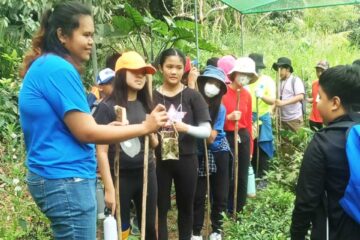Howard Gardner, an American developmental psychologist and a professor of Cognition and Education at the Harvard University, has made a breakthrough in the development of cognitive research in the year 1983. This is through his introduction of Multiple Intelligence Theory which mainly explains that people understand, perform, and express learnings in different ways.
THE EIGHT INTELLIGENCES:
There are originally seven intelligences in this theory which later on became eight. As explained, we all have these eight intelligences but each differs in degrees of dominance. Usually, a person possesses two to three dominant intelligences that s/he uses in everyday life. The eight intelligences are as follows:
Verbal-Linguistic Intelligence (Word Smart)
Learners who have a dominant verbal-linguistic intelligence use words effectively in learning and presenting what they have learned. They are able to read, write, and comprehend writings easily; and communicate fluently with the use of their language. Their common interest includes reading a book, playing word games, and writing novels and poems.
Logical-Mathematical Intelligence (Number Smart)
Learners who dominantly use logical-mathematical intelligence have a strong understanding of abstract, numbers, and logical reasoning. Aside from mathematics, they are also often good at science. Their love for formulas are also observed on how they form concepts first before going into details of a particular topic. Solving puzzles, mysteries, and logic games are their common hobbies.
Bodily-Kinesthetic Intelligence (Body Smart)
People who have a high bodily-kinesthetic intelligence learn a lot through physical movements. It can be dancing, simulations, exercises, or any physical activity they prefer. Further, it can be observed that learners with high bodily-kinesthetic intelligence tend to walk a lot and do other activities even while reading a book. It may look odd but they are learning from it.
Visual-Spatial Intelligence (Picture Smart)
Learners who are high in visual-spatial intelligence have been found out to learn more effectively when taught through drawings and images. Information can be easily retained if it is presented with charts and graphs as well. On the other hand, their way of presenting what they have learned is also through the same media where they have learned – graphs, images, and charts.
Musical Intelligence (Music Smart)
Learners who have a strong musical intelligence have also a creative way of learning things. They prefer to study with music in the background and apply rhythms to help them memorize words better. On the other hand, their way of presenting their learnings is through music as well. They compose music and play different instruments to communicate.
Visual-Spatial Intelligence (Picture Smart)
Learners who are high in visual-spatial intelligence have been found out to learn more effectively when taught through drawings and images. Information can be easily retained if it is presented with charts and graphs as well. On the other hand, their way of presenting what they have learned is also through the same media where they have learned – graphs, images, and charts.
Musical Intelligence (Music Smart)
Learners who have a strong musical intelligence have also a creative way of learning things. They prefer to study with music in the background and apply rhythms to help them memorize words better. On the other hand, their way of presenting their learnings is through music as well. They compose music and play different instruments to communicate.
Interpersonal Intelligence (People Smart)
Those who have a high interpersonal intelligence tend to have high empathy and fondness in interactions. Commonly, their most comfortable way of learning is through group works, brainstorming, and peer group sessions. On the other hand, they prefer presenting what they have learned through class reportings and doing speeches.
Intrapersonal Intelligence (Self Smart)
Those who have a dominant intrapersonal intelligence are noted to be independent learners. They study through introspection and private time. Although they present themselves as shy sometimes, the good thing about people with high intrapersonal intelligence is that they are fully aware of their interest and goals in life.
Naturalistic Intelligence (Nature Smart)
The naturalistic intelligence is the recent addition of Gardner to his seven intelligences. Those who are high in naturalistic intelligence find nature as their top interest. They love studying plants, animals, and everything about nature. They can even spot little changes in nature.
OUR EDUCATION SYSTEM’S TAKE
Our education system has implemented a structure that everyone is expected to adhere to – starting from the attendances, grading system, even teaching style. In this structure, the students’ intelligence is being measured by their score levels. Once you get high scores, you are intelligent and way above others; and if not, you are placed at the bottom of the class ranking.
The problem with adhering to the system is that you are not given enough space to express your own style and interest. You merely follow what the system dictates without actually learning. The worse part? You are being labeled with your weakness, while your strengths are being set aside.
Hence, multiple Intelligence theory can be best applied in this case. This theory gives awareness to educators that not all students understand, perform, and express learnings in a similar way. To address that, our educators should identify the differences of the students’ interest and style and apply it to the curriculum.
To guide us better, Linda Campbell, the author of “Variations on a Theme: How Teachers Interpret MI Theory”, describes the five approaches we can use of curriculum change:
Lesson design. Educators implement multiple intelligences in their lesson design. This is done by finding out the most appropriate intelligences that should be applied in a topic. Some use several intelligences, while some try to incorporate all intelligences in one topic. For example, in a geometry class, the teacher clearly does board discussion prior to other activities. After which, the teacher will now conduct role playing of the formulas that was used in the topic. So, if the student does not rely more on the board discussion, he can learn from the roleplaying activity instead.
Interdisciplinary units. Interdisciplinary is used by mentoring your students with different disciplines. In a classroom setting, this is commonly done when students were given open-ended questions and they are expected to answer it in their unique ways.
Student projects. Student projects are given to serve as an avenue for students to express their style in a solo work. The differences in the project can also identify what the intelligences are dominant in each student.
Assessments. Assessments, as one of the most important approaches, give the educators an avenue to assess if their style of teaching is effective. The students, on the other hand, are tested on how much they have learned. As proposed by Campbell, it will be better if you allow your student to choose on how he will be tested and assessed.
Apprenticeships. Apprenticeships allow students to experience things first hand. They are commonly exposed to the work environment they prefer, and are expected to execute the tasks that are given to them. This can also be an effective way for them to work with people with diverse intelligences.
CONCLUSION
Education’s primary responsibility is to allow children grow and learn. Hence, if we now begin to adapt changes in the curriculum based upon the multiple intelligences of students, we could provide a healthier learning environment to all learners.
Enjoyed this article? Your child can experience this kind of education too! Click on the button below to learn more!



